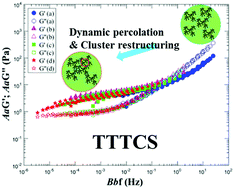Percolation behaviors of model carbon black pastes†
Abstract
The percolation behaviors of a series of high-structured carbon black (CB) pastes (CB weight fractions 10–25 wt%, ethyl cellulose as the binder, α-terpineol as the solvent) were systematically investigated using analyses of rheology and impedance spectra together with characterization via small-angle X-ray scattering (SAXS) and scanning electron microscopy (SEM). When the CB concentration was near the static percolation threshold (∼20 wt%), the permittivity, ac conductance, and elastic modulus of the paste displayed notable increases, whereas the SAXS profile revealed the prevalence of isolated CB aggregates (mean radius of gyration ∼40 nm). Upon further aging at 25 and 40 °C (up to 6 h), two CB pastes near the static percolation threshold (i.e., 20 and 25 wt%) exhibited prominent temporally evolving responses, including more than tenfold increases in their ac conductance and elastic modulus, as well as a pronounced upturn in the low-q SAXS profile (q < 0.03 nm−1) and the formation of a (partially) interconnected cluster network in SEM observations of the morphologies of screen-printed films. In this case, we provide the first evidence of “(aging) Time-(relaxation) Time-Temperature-Concentration Superposition (TTTCS)” for the dynamic modulus data over a frequency range of seven orders of magnitude. This suggests that prolonged aging time imparted to CB aggregate interaction and restructuring (or gelation) may work in tandem with the known effects of the system temperature and concentration to further extend the accessible range of dynamic modulus data, in a similar way to recent reports on the effect of the curing (crosslinking) time on a carbon nanotube suspension and caramel. In combination with existing (three) master curves for two different colloidal materials, we show that there is a reasonable superposition of all the dynamic modulus data over a frequency range of 12 orders of magnitude.



 Please wait while we load your content...
Please wait while we load your content...